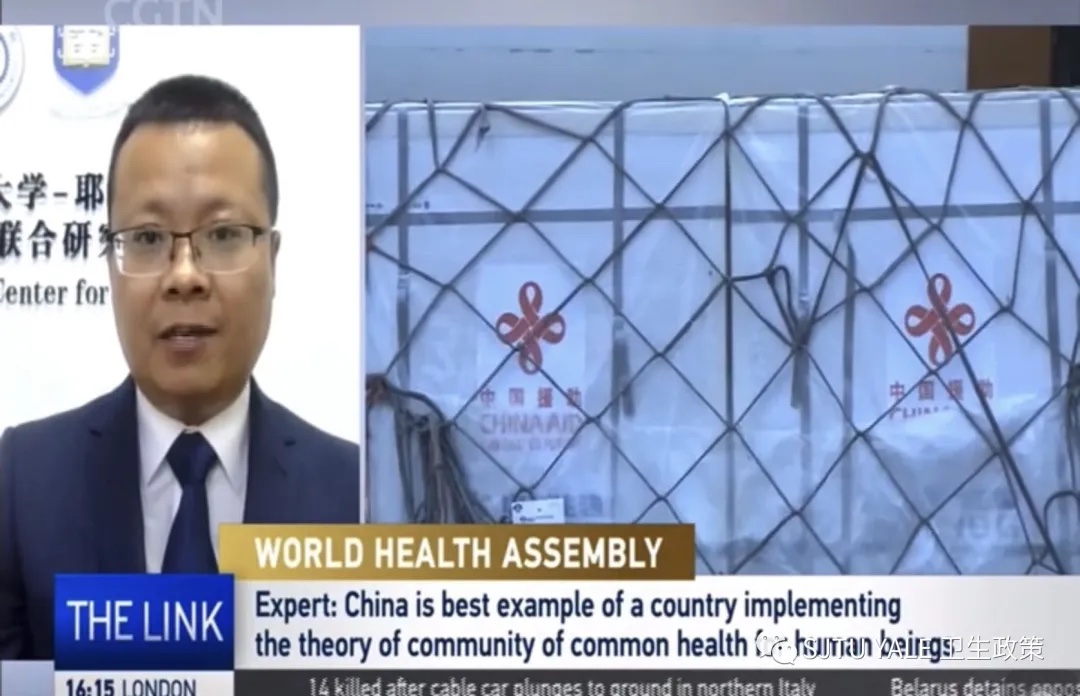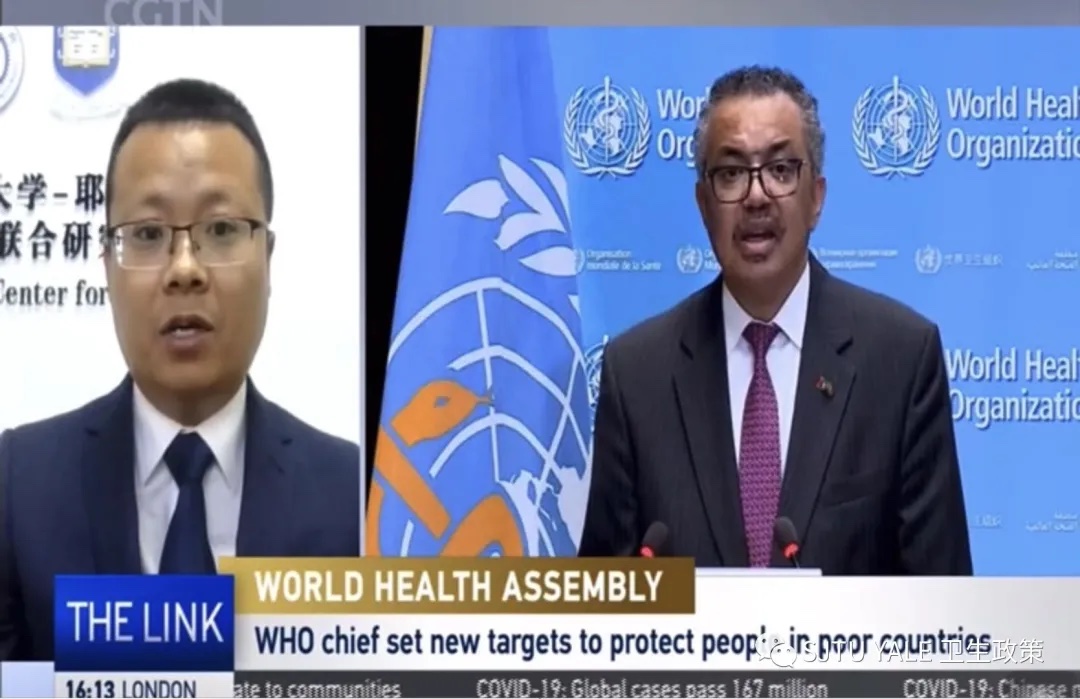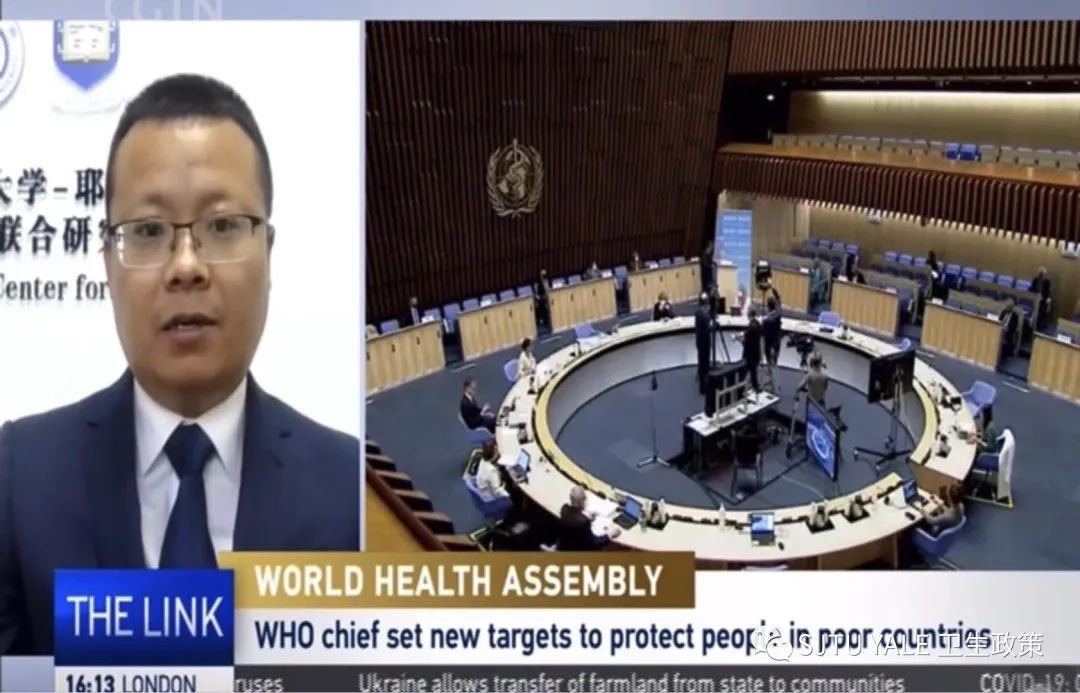上海交大赵大海教授接受央视专访:中国为抗击全球新冠大流行发挥了最重要作用

上海交通大学国际与公共事务学院教授、博士生导师,上海交通大学-耶鲁大学卫生政策联合研究中心执行主任赵大海,自新冠肺炎疫情暴发以来,对于新冠疫情暴发、防控以及卫生政策第57次接受中央电视台的直播专访,也是第91次接受央视、上视专访。2021年5月24日,赵大海在中央电视台英语频道《链接天下》节目,就世界卫生组织总干事谭德塞在当日举行的成员国卫生部长会议提出的新冠疫苗分配新目标、中国为抗击新冠全球大流行发挥的作用等相关话题进行了解释和评论。现将有关访谈内容翻译并摘录如下。

主持人:(世界卫生组织总干事)谭德塞博士提出了旨在保护世界上最贫穷国家人民的新冠疫苗分配新目标。如你所知,超过75%的新冠疫苗只集中在了10个国家接种。请问世界卫生组织如何通过新冠肺炎疫苗实施计划(COVAX)机制改善新冠疫苗的全球分配?
赵大海:当前COVAX的主要作用机制是希望通过“抗击新冠肺炎工具加速器” (ACT Accelerator)来实现。该作用机制主要分为如下三步。第一,有能力捐赠新冠疫苗的国家需要立即通过COVAX计划捐赠数千万剂新冠疫苗出来。第二,未来几周和几个月的时间内,COVAX还需要数亿剂疫苗。疫苗生产企业应帮助COVAX做好快速的捐赠工作,并给予COVAX对所有未承诺新冠疫苗归属剂量的优先拒绝权。第三,COVAX需要通过自愿许可、共享技术和放弃知识产权来扩大新冠疫苗的生产。然而,要基于上述机制的COVAX真正实现新冠疫苗的全球分配,尚需要弥补180亿美元的资金缺口,实施难度很大。

主持人:中国已向世界提供了超过3亿剂新冠疫苗,预计还将提供更多的疫苗。中国在国内的疫苗接种剂量是5亿剂左右。到目前为止,您如何评价中国在全球应对新冠大流行中的作用?
赵大海:中国为抗击全球新冠大流行所做的一切,是世界上所有国家的最佳榜样。首先,在中国加入COVAX之前,COVAX的所有成员国都没有生产新冠疫苗的能力。进而,中国生产的所有新冠疫苗的近40%已提供给了中国以外的国家,这已充分证明了中国在帮助世界抗击全球新冠大流行方面已发挥了最重要的作用。其次,中国在新冠全球大流行期间所做的一切已充分表明,中国是践行人类命运健康共同体的最佳范例。除了中国向世界提供的大量新冠疫苗之外,中国还向发展中国家提供了20亿美元的援助,以及向世界提供了包括口罩在内的大量医用防护物资。我们期待发达国家,特别是那些有充分能力向其他国家提供新冠疫苗的国家,效仿中国的做法,帮助世界来尽快结束这场新冠全球大流行。
供稿者:国务学院
日期:2021年5月25日
Dahai ZHAO’s Exclusive Interview with CGTN: China has played the most important role in global response to COVID-19
Dahai Zhao, a doctoral supervisor at the School of International and Public Affairs of Shanghai Jiao Tong University and Executive Director of Shanghai Jiao Tong University-Yale University Joint Research Center for Health Policy, has been interviewed by CGYN for the 57st time (the 91st time by CGTN / ShanghaiTV) since the COVID-19 pandemic. On May 24, 2021, Zhao commented on WHO Director-General Tedros putting forward the new target for the distribution of COVID-19 vaccine at the meeting of health ministers of member states and China's role in combating the global pandemic on “The Link” of CGTN.
Anchor: Thank you Professor Zhao for joining us. Dr. Tedros has set new targets for protecting people in the poorest countries. As you know, more than 75-percent of all vaccines have been administered in just 10 countries. How can the world health agency improve global distribution of vaccines through its COVAX mechanism?
ZHAO: First, tens of millions of doses of COVID-19 vaccines need be donated immediately through COVAX by the countries who have the ability to donate. Second, hundreds of millions more doses of vaccines are needed in the coming weeks and months. The vaccine production companies should help make donations happen fast, and to give COVAX the first right of refusal on all uncommitted doses. Third, COVAX needs scale up production of all of these tools, through voluntary licensing, sharing technology, and waiving intellectual property rights. However, to realize the aforementioned global distribution of vaccines though the COVAX, need to close the 18 billion US dollar funding gap for the ACT Accelerator.
Anchor: China has provided over 300 million doses to the world and more are expected. The country has administered over 500 million doses domestically. How do you evaluate China's role in the global response to the pandemic so far?
ZHAO: What China has done for combating the global pandemic is the best example for all countries. First, before China’s joining COVAX, COVAX had no countries that had probability to produce COVID-19 vaccines. Further, about 40% of the total vaccines produced by China have been provided to outside of China fully confirms that China has played the most important role in helping the world to combat the global pandemic. Second, what China has done during the pandemic demonstrated that China is the best example of the implementation of the theory of a community of common health for human being. Besides of the vaccines provided by China, China has also provided 2 billion USD to help developing countries and supplied a huge number of protective materials to the world. We expect developed countries, particularly those have the full probability to provide vaccines to other countries, follow what China has done, to help the world to end the global pandemic.
Contributor: SIPA, SJTU
Date: May 25, 2021

